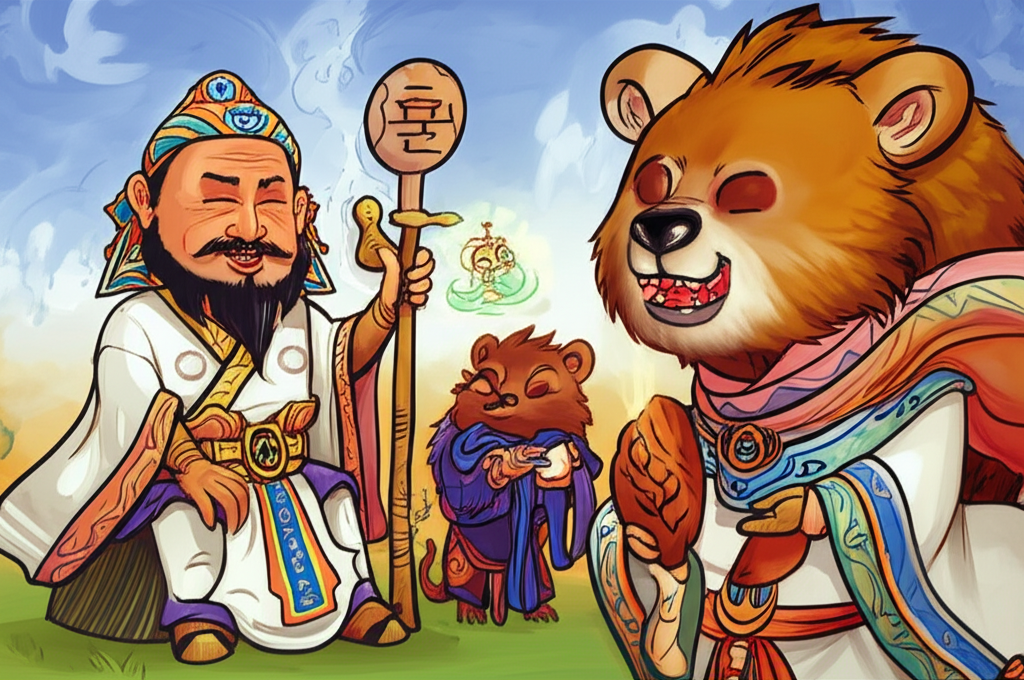
In the tapestry of ancient East Asian folklore, woven with threads of shamanism, ancestor worship, and a deep reverence for the natural world, lies the captivating legend of Dangun. This foundational myth hails from the Korean peninsula, a story passed down through generations, whispered around hearths and recited in solemn ceremonies by the ancient peoples of the region. It is crucial to understand that this is a traditional narrative, a product of human imagination and cultural storytelling, not a historical account or a matter of religious doctrine.
The era in which the Dangun legend likely took root was one of burgeoning tribal societies on the Korean peninsula, a time when understanding the cosmos and human existence was deeply intertwined with the visible world. These ancient peoples lived in close proximity to nature, their lives dictated by the cycles of the seasons, the bounty of the land, and the often-unpredictable forces of weather and wildlife. Their worldview was animistic; they perceived spirits residing in mountains, rivers, trees, and animals. The celestial realm was also a source of wonder and influence, with the sun, moon, and stars holding significant meaning. Leadership was often attributed to those who demonstrated strength, wisdom, and a perceived connection to these spiritual forces, blurring the lines between the earthly and the divine in their storytelling.
At the heart of the Dangun legend is the celestial being, Hwanung. He is depicted as the son of Hwanin, the Lord of Heaven. Hwanung, in this narrative, is a figure of divine lineage, imbued with the desire to descend to the earthly realm and govern humankind. His symbolic attributes lie in his celestial origin, representing a connection to the heavens and a higher order. He is often portrayed as a benevolent ruler, possessing the wisdom and authority to establish order and civilization. His descent is not an act of conquest, but one of benevolent stewardship, a desire to bring structure and knowledge to the nascent human societies of the time.
The narrative unfolds with Hwanung’s yearning to leave his heavenly abode. His father, Hwanin, grants his wish, bestowing upon him three heavenly seals, symbols of authority and celestial backing, and dispatching him with three thousand followers to Mount Taebaek. There, he establishes a divine city and governs the people, bringing laws, agriculture, and various arts.
It is during this time that a significant transformation occurs, a pivotal moment in the legend. A bear and a tiger, inhabitants of a cave near the divine city, express a fervent wish to become human. Hwanung, moved by their earnest desire, presents them with a bundle of mugwort and twenty cloves of garlic, instructing them to consume these sacred offerings and remain in the cave for one hundred days, avoiding sunlight. The tiger, impatient and unable to endure the confinement and the peculiar diet, flees. The bear, however, perseveres. After twenty-one days, enduring the darkness and the prescribed sustenance, the bear transforms into a woman. This transformed woman, named Ungnyeo, meaning "bear woman," becomes the object of Hwanung’s affection. He marries her, and together they conceive a son.
This son, born of a celestial father and an earthly, transformed mother, is named Dangun Wanggeom. He is presented as the progenitor of the Korean people. The legend states that Dangun established his capital at Pyongyang and later moved it to Asadal, reigning for fifteen hundred years. After his long reign, he ascended Mount Taebaek once more, becoming a mountain god.
The Dangun legend, while fantastical, is rich with symbolic meaning for the ancient Koreans. The celestial descent of Hwanung can be seen as representing the aspiration for order and civilization, a guiding force from above shaping the nascent human society. The bear and tiger, common symbols in East Asian folklore, represent different aspects of the natural world and perhaps different tribal groups. The bear’s perseverance and transformation symbolize the potential for change and the acquisition of higher qualities through discipline and adherence to divine guidance. The garlic and mugwort are often interpreted as having spiritual or purifying properties in traditional Korean shamanism. Dangun himself embodies the ideal ruler, a bridge between the divine and the human, possessing both celestial wisdom and earthly connection. His eventual ascension to mountain godhood reinforces the belief in the sacredness of nature and the enduring influence of ancestral figures.
In modern times, the Dangun legend continues to hold cultural significance, albeit in a transformed context. It is primarily studied and appreciated within the realms of literature, cultural history, and mythology. It serves as a cornerstone of Korean national identity, a foundational story that speaks to the origins of their civilization. The legend has been retold and reinterpreted in various forms, from historical dramas and animated films that capture the mythical elements to academic analyses that explore its anthropological and sociological implications. In the realm of video games, elements of Korean mythology, including figures and themes inspired by Dangun, can sometimes be found, offering a modern, imaginative engagement with these ancient narratives.
It is vital to reiterate that the legend of Dangun is a cultural artifact, a testament to the rich storytelling traditions of the Korean people. As Muslims, we recognize that only Allah (God) is the true Creator and Sustainer of all existence, and that all power and authority originate from Him alone. This understanding guides our perspective as we explore narratives from different cultures. The Dangun legend, therefore, is not a belief system to be adopted, but a fascinating window into the past, a story that reveals the ancient Koreans’ worldview, their aspirations for leadership, and their deep connection to the natural and celestial realms. It is through the exploration of such cultural heritage that we gain a broader understanding of human imagination, the power of storytelling, and the diverse ways in which societies have sought to explain their origins and their place in the universe.





